
By Vicky Richter
In late September, Hurricane Ian slammed into mainland Florida. This hurricane was nearly a Category 5 and in just hours, changed the lives of hundreds of thousands of Florida residents. Governor Ron DeSantis responded quickly and decisively to prevent the greatest possible damage to Florida residents.
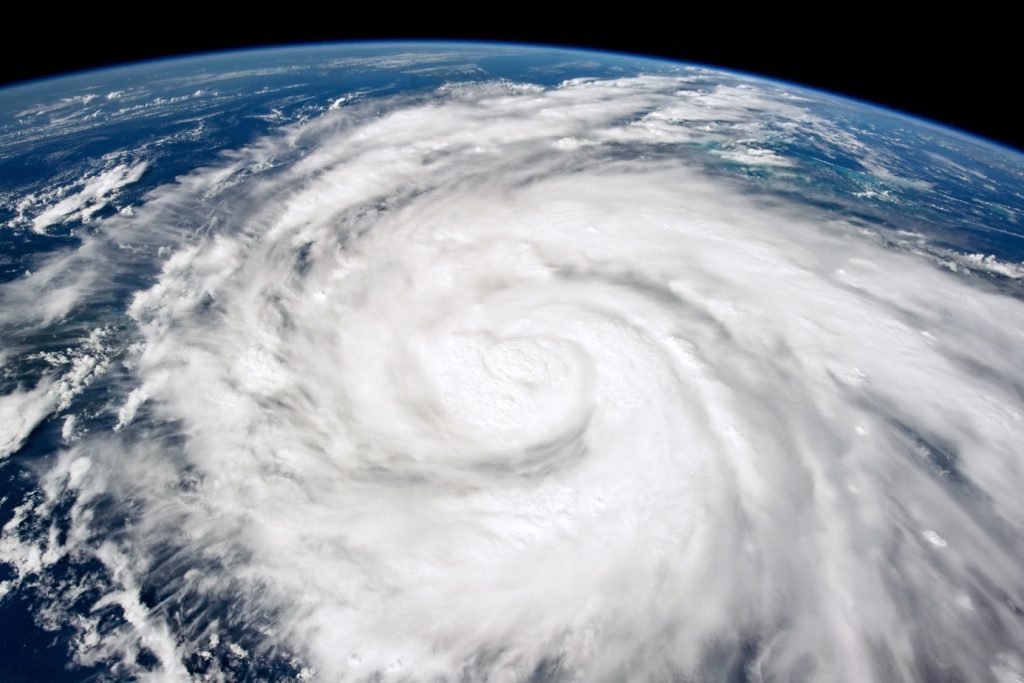
Because of the unusually high sea surface temperatures in the Caribbean Sea and the Gulf of Mexico and with the other atmospheric conditions that were created, a huge reservoir of energy became available to developing tropical cyclones. Hurricane IAN now appears to have exploited this potential to a great extent, ultimately ranking among the strongest and most devastating hurricanes ever to hit Florida and the United States.
On Tuesday morning (September 27) Central European Time, IAN crossed the west of Cuba after rapidly intensifying already as a Category 3 hurricane with wind speeds around 200 km/h and heavy rain. Massive damage to the infrastructure was already evident there, and larger parts of the country were without power for two days.
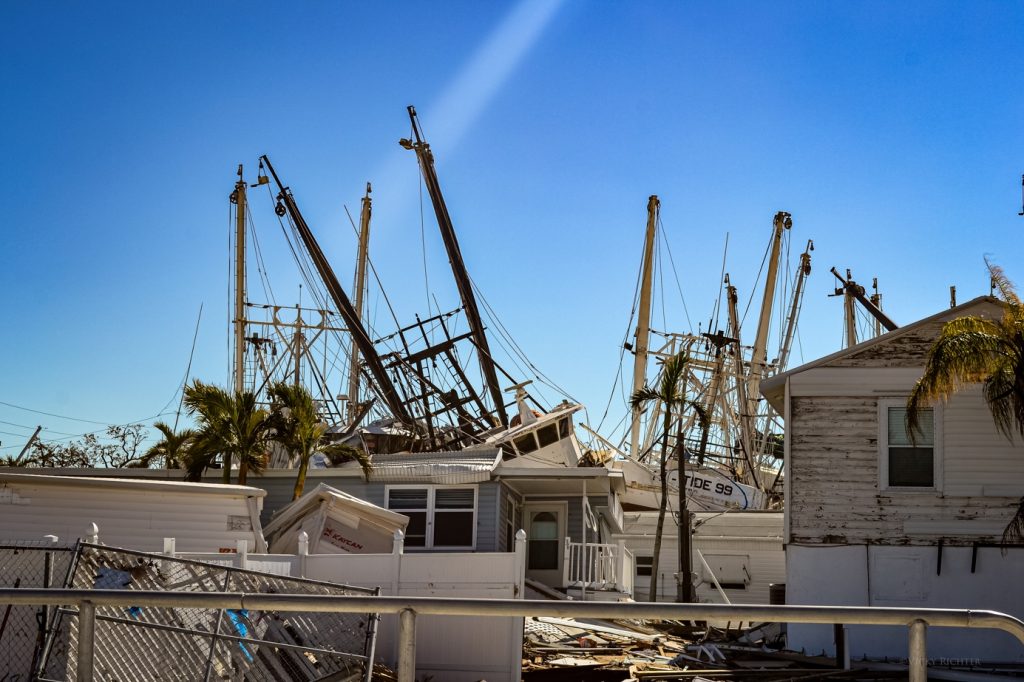
IAN then gradually strengthened over the Gulf of Mexico, reaching its peak of development at midday on Wednesday (September 28). It matured into an extremely dangerous category 4 hurricane, producing wind speeds of 250 km/h at a core pressure of 937 hPa. By this time, IAN was already just off the southwest coast of Florida. The window of opportunity for weakening before landfall, which meteorologists had identified in advance due to increasing wind shear over the southeastern United States, thus shrank to a minimum. Consequently, at about 21 CEST on Wednesday evening, IAN struck the coast near Fort Myers with almost full force as a still-destructive second-highest category hurricane with a core pressure of 940 hPa and mean wind speeds of up to 240 km/h. In terms of wind speeds, it was the fourth strongest hurricane ever to hit Florida and the ninth strongest in the weather history of the United States of America.
In addition to its strength, the storm’s extremely slow shifting proved to be particularly problematic. Near the “eyewall” (the wall of clouds arranged in a circle around the cloudy and windless “eye” of the storm), hurricane conditions prevailed for hours on the southwest coast of Florida. On the southern flank of the storm, the wind blew from the west, so that in addition, enormous amounts of water were pushed from the sea toward the coast and bays. This led to historically high storm surges there of up to 5 meters in height. Inland, the storm slowly weakened, but the heavy rainfall did not. With rainfall amounts in some cases exceeding 300 liters per square meter within 12 to 24 hours, equivalent to almost two-thirds the annual precipitation in Berlin, extensive areas of flooding also formed inland, particularly in a strip from Fort Myers and Tampa through Orlando in a northeasterly direction to the Atlantic coast. According to data from the U.S. Weather Service, in some regions this was an event that statistically occurs only once every 1,000 years.
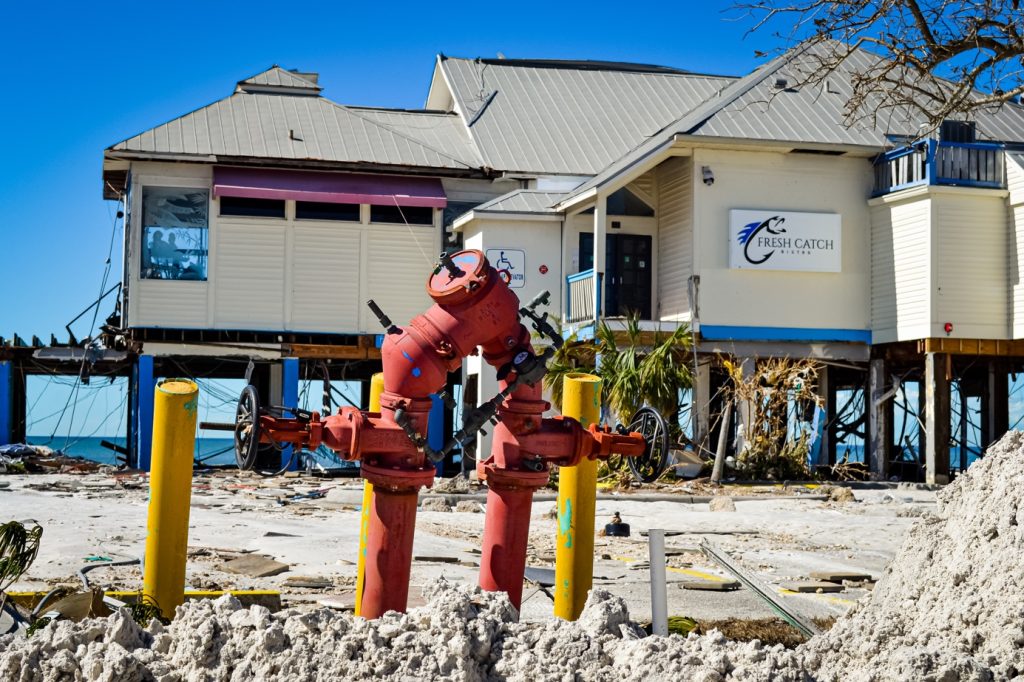
Pine Island, along with Fort Myers and surrounding counties, was hit the hardest. For days after the hurricane, reports of missing people were still being filed with authorities, and first responders could only reach the island via boat or helicopter. Trailer home communities were completely destroyed. The helplessness of residents was pervasive. What official first responders were able to handle due to time constraints was taken over by relief organizations from across America. For example, the Aerial Recovery Group, which first conducted search and recovery missions, moved on to health checks, basic care assistance, and roof tarping.
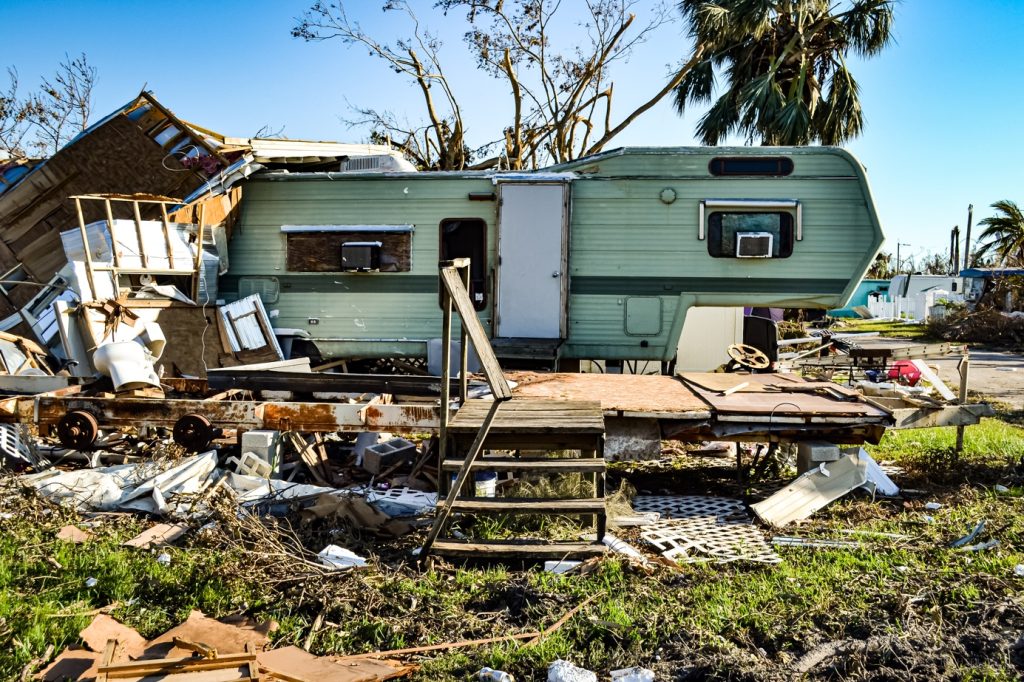
I had the chance to accompany the Hurricane Relief Team, “Aerial Recovery Group,” on Pine Island for ten days. In an interview with team leader John Witherspoon and volunteer Chad Golden, I learned about the mission of this veteran-led organization and what John and Chad did with the Aerial Recovery Group team after Hurricane Ian in the Fort Myers area.
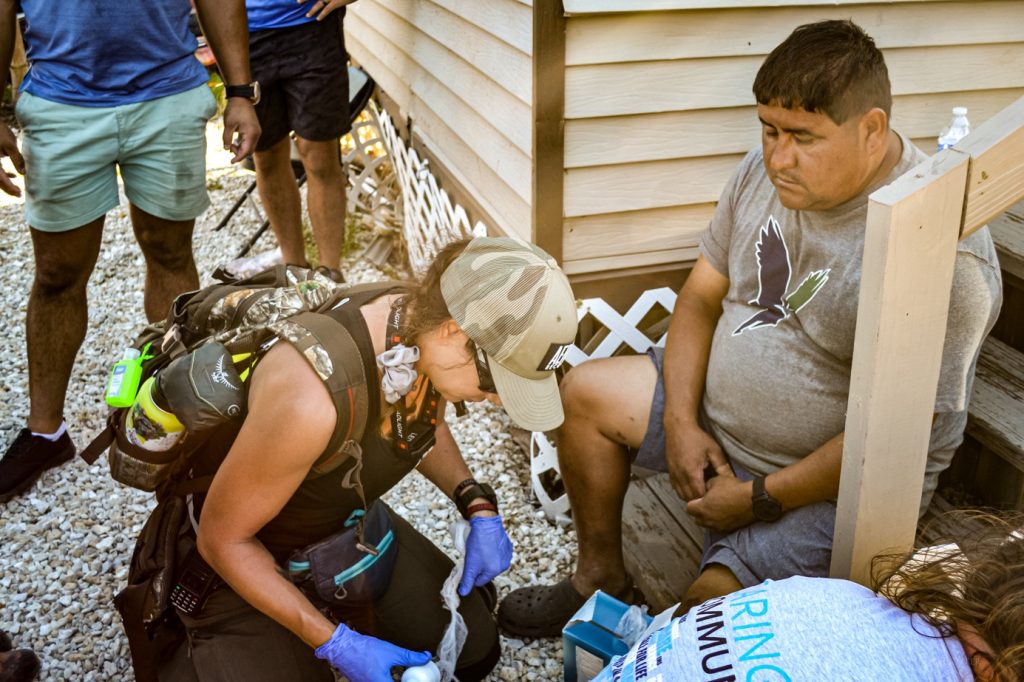
How long have you been working with Aerial Recovery?
I was with Ariel from the beginning. We started talking about it and preparing it in 2019. At the beginning of 2020, we started putting the antenna together.

Was it envisioned from the beginning as a veteran-led organization to help clean up disasters, or was it a growing idea along the lines of, okay, now we have a bunch of veterans, so why not incorporate some military training?
Yeah, in the beginning it was veterans who came up with it. I guess it started as kind of a veteran’s organization, just because of who we are. And it was really about putting not just a veteran, but a Special Forces spin on disaster relief. Because of the way we work with other organizations, cultures, and governments, typically in our military role, it was about how do you, I guess, organize the local population in a disaster. Organizing the local population in a disaster, supporting the operations centers and the governments in a disaster, those kinds of things. But how to add a special touch to it, which is Special Forces. And after we started doing that, we decided that we need to train volunteers so that when they arrive, they know how to proceed, so that they have skills that are helpful when they arrive and volunteer.
Why did you volunteer for this mission and come to Aerial Recovery?
I had already worked with the Aerial Recovery Group in 2020 after Honduras was hit by two hurricanes within two weeks. I met Jeremy through a mutual friend in the Army. Helping in Honduras was an experience I will never forget. Seeing these people survive while coming together as a community to help each other was something so amazing to see in the midst of the hurricane’s destruction. I have always helped anyone in need, and when I saw the devastation Hurricane Ian caused, I had time on my hands and I knew Aerial Recovery would be there to help, so I messaged Jeremy and asked if I could help.

When did Aerial decide to go to Florida with Ian to help? Was it when they first heard it would hit Cuba?
So, yes, we decided before he hit Cuba. We got the reports that he was going to hit Florida, and of course the model kept changing and we didn’t know exactly where he was going to hit, but before it hit Cuba, we decided that we would respond. So it was probably the 27th or 28th, I am not 100% sure. So that started the whole process of planning and preparing the response.
Can you tell me a little bit about how you plan these events? You can’t really plan it, because it’s an unpredictable situation. But what forces do you activate before you go out and get your boots on the ground?
Once we decide to go there and we have a general idea of where the hurricane is going to go, we create our concept of operations and how we’re going to respond to it. Obviously, if we don’t know exactly where it’s going to make landfall, we just have to get here and then see where the storm is going to move to respond to it. So in our concept of operations, we start with the question, who is coming? It’s kind of a five W. So who’s going? What are we going to do? What’s the situation we’re going into? We do a situation analysis, like: Here are the threats from the storm, here are the threats from the post-storm activities, and so on. Here are the emergency response numbers, the people in the area where we expect the storm to hit, and just different forecasts. For example, if the storm surge is this high, this many people will be affected, our demographics.

Have you ever had problems with the official federal search and rescue team?
I have not had any bad experiences with first responders. I think in the early stages of disaster relief/recovery, any constructive/proactive help is welcome. Perhaps it has to do with the fact that Aerial Recovery is run by former Army soldiers who I think know what it takes and how to work well with others in a high stress, high risk environment.
I have to say that it depends more on the particular region, if that makes sense. And sometimes the smaller the organization or the more local the organization, the more they want your help. For example, in Mayfield, Kentucky, we were very welcomed because I intentionally went there and coordinated everything with them and gave them feedback on everything we were doing, and we worked great together. But this is a town of 15,000, 20,000 people, you know what I mean? So it’s a smaller, more local community. So it was easy to do that, because after all, I knew everybody there by their first name and so forth. Now when you come to Lee County, Florida, it’s a much bigger machine and a much bigger operation. There are a lot more people involved at the center. I did coordinate and talk to them a lot, but with a larger organization, sometimes you get a little bit more of that, “No, we’re good, we have it.” But in general, my experience has always been that if you coordinate with them early and often, they eventually start to trust you to do what you promise.
And if we had known for sure that this thing was going to hit Lee County, it would have been beneficial to call them and coordinate with them in advance to let them know that we were coming and that we were able to do this. That is what we intend to do.
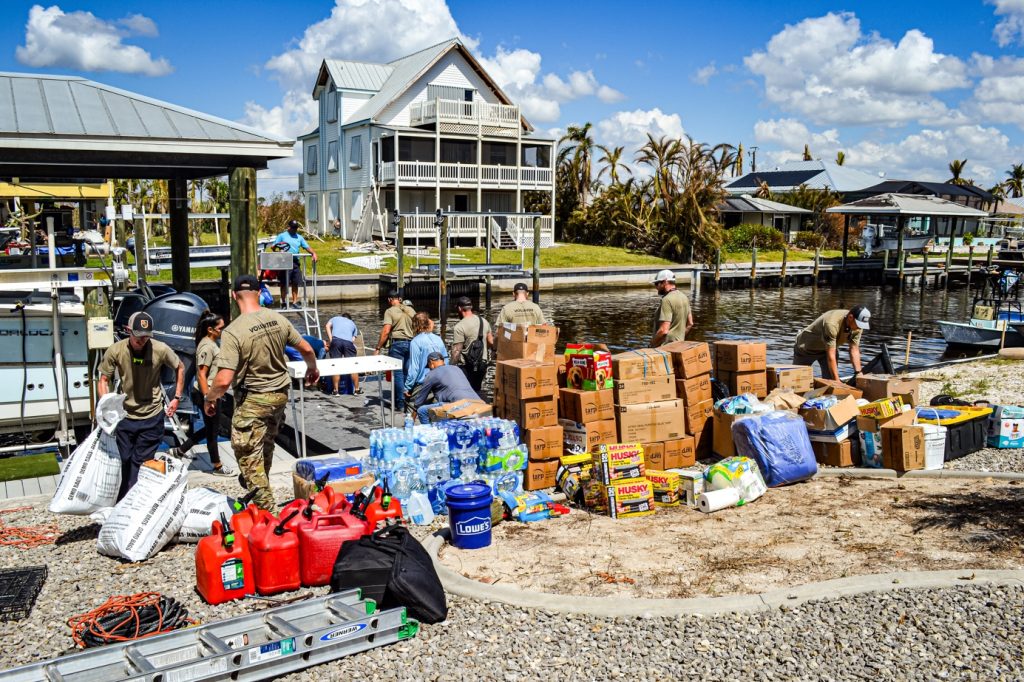
GEORGE:
Do you think your help was welcomed by the people of Pine Island?
Chad Golden:
I did. Our help was limited, we were a small group with 100% donated items. The help we were able to provide, limited as it was, seemed to give some hope to the people we were able to meet and support. Hope seemed to help more than anything else. Something as simple as pumping up a car tire for a woman with an air compressor I have in my truck overwhelmed her with a sense of relief.
GEORGE:
What did you take away most from this event?
Chad Golden:
For me, it was a stark reminder that as an individual or as a family, you definitely need to be able to sustain life for at least 7 days when such an event occurs. Especially in areas where such natural disasters are common. You could say it is a personal responsibility.
John Witherspoon:
Right. The first one was probably the most positive thing, being able to help others and seeing others volunteer to do the same thing. And that’s something that I realized in the process, that other people don’t do it for that reason. It’s a side effect, you could say, that it’s therapeutic for them to help other people and sort of have a mission or a goal or something, especially for former military, because that’s what you did all those years in the military, and then you’re out and you don’t have that anymore and you miss it. You miss the camaraderie, the goal of helping others and things like that. For some of them, I think it was therapeutic to go out there and actually help others, so you get the benefit of actually helping people in need, and then what that means to the person helping, which I never thought about until I had this experience.
I think we’ve worked really well together, a lot of us. The ones that we have actually partnered with and collaborated with. But that’s, I think, with any disaster. It takes a while for everybody to make those initial adjustments so that they work better together, and maybe that’s something that we need to work on before a disaster.

Oh, I especially took away the realization that the people who come to do this work become a little more alive as a result. They come as volunteers. And as you remember, they were not easy days, it was hard work. But when you volunteer, when you risk a little bit to help others, when you feel a little bit uncomfortable, when you struggle a little bit, but also when you serve others and do good, life comes alive again. That’s what I take away, is to realize how much that makes people come alive. My big win, besides all the people that we helped, that we rescued, that we evacuated, that we roofed, that we provided health and welfare checks to, is probably the new friends among the volunteers. Hopefully we will all go back to helping others in the future and continue to grow the team of volunteers and supporters.
I run everything like a family. When I’m in the military, we run everything like a family, and that works pretty well.
Can you tell me how it felt for you to see people from all states coming together and helping people and what it means for you as an American?
Yeah, the interesting thing about America is how big it is, right? Unlike many other countries, where when something like this hits a country the size of Germany, a much larger percentage of the country is affected, right? But I think they always talk about the American spirit and things like that. I think deep down we still have a lot of that. Maybe it has diminished a little bit because of the iPhones. I don’t know if the iPhones are really the reason, but people are becoming more selfish, and so maybe it has diminished a little bit. But I think deep down, it’s still there. But it’s mostly the attitude that you can do anything. That’s right. I’ll find a way to solve this problem, or whatever the problem is. Finding creative ways to solve problems and fix problems, not just following the rules, so to speak.
Governor Ron DeSantis held press conferences in Fort Myers and North Port when the mainstream media and President Joe Biden tried to politicize Hurricane IAN and make it a consequence of climate change. The question of whether Hurricane IAN is a consequence of the climate crisis cannot be answered so easily, since it is not possible to draw direct conclusions about climate change from individual events. This was also communicated by the Florida government, which focused on helping the affected regions rather than discussing a new Green Deal in the U.S., which mainstream media and Washington D.C. tried so hard to do. DeSantis responded days before the hurricane hit the Floridian mainland with disaster response and preparations to repair the imminent damage.
Do you think the mainstream media is right in blaming climate change for this hurricane and its destruction?
I have no expertise in this area. But I do have some common sense. I believe that climate change had nothing to do with hurricane recovery efforts in any area of Hurricane Ian’s path of destruction. I think it would be very helpful if the media would help with recovery efforts in all natural disasters. They have resources, a lot of resources.
Do you think Governor DeSantis has done his job right?
It is easy for anyone to criticize Governor DeSantis’ response to Hurricane Ian. However, there were people on Pine Island who told me they saw first responders (sheriffs, police officers, etc.) being flown by helicopter to the northern Pine Island area within hours of Ian passing. The state also had hundreds of utility vehicles on standby waiting to respond and get utilities back on line. The only bridge/road leading to Pine Island was destroyed by the hurricane. Within a few days, the road was repaired to the point where utility vehicles, police officers and other first responders could get to the island. In the end, any action is better than no action.
Ron Desantis is secure in the Governor’s seat and Hurricane Ian has only made him more popular. Ron DeSantis showed leadership and a clear head in the worst natural disaster in Florida in 1000 years, not being swayed by narratives or agendas. The respect for Desantis from Floridians was confirmed with an election victory on November 08, 2022.
I was in it and there were many tornados as well. You could hear the high pitch and low pitch hums. HARP!?! The people who came after from many states were awesome and their hard work to clear huge old oaks, for example, for days and hours on end and sleeping in whatever they could find. One amazing woman in a subdivision offered a Texas group showers in her home. A generous and big hearted woman.